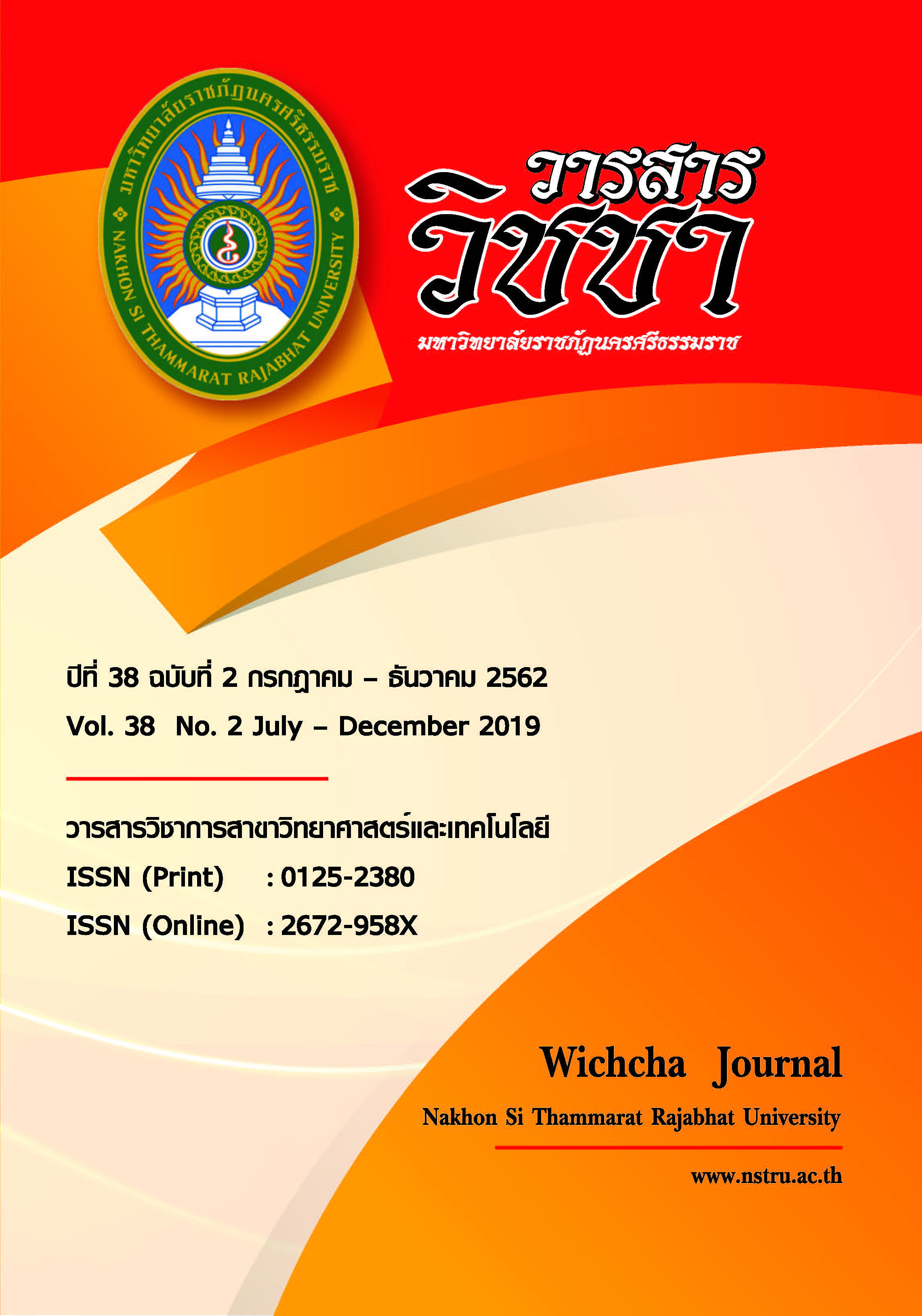Developement of Boiled Betong Chicken with Chinese Herbal Recipe การพัฒนาผลิตภัณฑ์ไก่เบตงตุ๋นสมุนไพรจีน
Main Article Content
Abstract
The objective of this research was to develop the boiled chicken with the Chinese herbal recipe. The optimized Chinese herbal formula that was accepted by the consumers was evaluated and the effect of boiling time on the quality of Betong chicken meat was studied. It was found that the optimized Chinese herbal formula for the production of boiled chicken with the Chinese herbal recipe was 1,000 g chicken, 2,000 g water, 54 g salt, 190 g sugar, 60 g soy sauce, 25 g black pepper, 8 g dried longan, 10 g dried Chinese wolfberry, 19 g dried Chinese yam, 10 g dried Milkvetch root and 12 g dried Solomon's seal. The boiling time in boiling water causes a greater percentage of chicken weight loss. The weight loss of the boiled chickens at 1.0, 1.5, 2.0, 2.5 h was 29.85, 30.00, 32.45 and 34.20%, respectively. The lightness (L*) of chicken meat decreased and the texture of the chicken meat became softer with increased boiling time. The optimum boiling time for Betong chicken was 2.0 h which it obtained the highest total acceptability from the panelists.
Article Details
เนื้อหาและข้อมูลในบทความที่ลงตีพิมพ์ในวารสารวิชชา มหาวิทยาลัยราชภัฏนครศรีธรรมราช ถือเป็นข้อคิดเห็นและความรับผิดชอบของผู้เขียนบทความโดยตรง ซึ่งกองบรรณาธิการวารสารไม่จำเป็นต้องเห็นด้วยหรือร่วมรับผิดชอบใด ๆ
บทความ ข้อมูล เนื้อหา รูปภาพ ฯลฯ ที่ได้รับการตีพิมพ์ในวารสารวิชชา มหาวิทยาลัยราชภัฏนครศรีธรรมราช ถือเป็นลิขสิทธ์ของวารสารวิชชา มหาวิทยาลัยราชภัฏนครศรีธรรมราช หากบุคคลหรือหน่วยงานใดต้องการนำข้อมูลทั้งหมดหรือส่วนหนึ่งส่วนใดไปเผยแพร่ต่อหรือเพื่อการกระทำการใด ๆ จะต้องได้รับอนุญาตเป็นลายลักษณ์อักษรจากวารสารวิชชา มหาวิทยาลัยราชภัฏนครศรีธรรมราชก่อนเท่านั้น
The content and information in the article published in Wichcha journal Nakhon Si Thammarat Rajabhat University, It is the opinion and responsibility of the author of the article. The editorial journals do not need to agree. Or share any responsibility.
References
เบตงเพื่อการค้าและเพาะพันธุ์ไก่เบตง. ใน รายงานสรุปผลการดำเนินงานคลินิกเทคโนโลยี วิทยาลัยเทคนิคปัตตานี. ปัตตานี: วิทยาลัยเทคนิคปัตตานี.
ปิ่น จันจุฬา วรวิทย์ วณิชาภิชาติ สมศักดิ์ เหล่าเจริญสุข และธำรง ทองจำรูญ. (2545). การเลี้ยงไก่
เบตงในหมู่บ้านใน 3 จังหวัดชายแดนภาคใตของประเทศไทย: การศึกษาลักษณะปรากฏการเจริญเติบโต เปอรเซ็นต์ซาก และลักษณะการผลิตไข่ของไก่เบตง. วารสารเกษตร, 20(3), 278-288.
พิมพ์เพ็ญ พรเฉลิมพงศ์ และนิธิยา รัตนาปนนท์. (2561). การตุ๋น. สืบค้นเมื่อ 5 พฤษภาคม 2561, จาก: https://www.foodnetworksolution.com/wiki/word/3438/การตุ๋น-stewing.
สัญชัย จตุรสิทธา. (2543). เทคโนโลยีเนื้อสัตว์. เชียงใหม่: ธณบรรณการพิมพ์.
สุชน ตั้งทวีวิพัฒน์ วิไลพร ทัณฑะรักษ์ จรัญ ใจลังกา วาสนา แก้วโพธิ์ สมเดช วงศ์ชัยพาณิชย์
ศิริพร กีรติการกุล และสมพิศ ชูแสงจันทร์. (2557). หมู่บ้านไก่ดำตุ๋นยาจีนดอยแม่สลอง. กรุงเทพฯ: ภาควิชาสัตวศาสตร์และสัตว์น้ำ คณะเกษตรศาสตร์ มหาวิทยาลัยเชียงใหม่.
สุภาลักษณ์ มากชุมพล ชัยภูมิ บัญชาศักดิ์ ธีรวิทย์ เป่ยคำภา กีรติกร พูลทวี และเชาว์วิทย์ ระฆังทอง. (2558). การเปรียบเทียบคุณภาพเนื้อไก่กระทง กับไก่เบตง (สายพันธุ์เคยู). ใน การประชุมทางวิชาการของมหาวิทยาลัยเกษตรศาสตร์ ครั้งที่ 53 (หน้า 836-843). กรุงเทพฯ: มหาวิทยาลัย เกษตรศาสตร์.
Bailey, A.J. and Light, N.D. (1989). Connective tissue in meat and meat products. London: Elsevier Applied Science.
Califano, A.N., Bertola, N.C., Bevilacqua, A.E. and Zaritzky, N.E. (1997). Effect of processing conditions on the hardness of cooked beef. Journal of Food Engineering, 34(1), 41-54.
Crehan, C.M., Hughes, E., Troy, D.J. and Buckley, D.J. (2000). Effects of fat level and maltodextrin on the functional properties of frankfurters formulated with 5, 12 and 30% fat. Meat Science, 55(4), 463-469.
Dawson, P.L., Sheldon, B.W. and Miles, J.J. (1991). Effect of aseptic processing on the texture of chicken meat. Poultry Science, 70(11), 2359-2367.
Martens, H., Staburvik, E. and Martens, M. (1982). Texture and colour changes in meat during cooking related to thermal denaturation of muscle proteins. Journal of Texture Studies, 13(3), 291-309.
Murphy, R.Y. and Marks, B.P. (2000). Effect of meat temperature on properties, texture, and cook loss for ground chicken breast patties. Poultry Science, 79(1), 99-104.
Obuz, E., Dikeman, M.E., Erickson, L.E., Hunt, M.C. and Herald, T.J. (2004). Predicting temperature profiles to determine degree of doneness for beef biceps femoris and longissimus lumborum steaks. Meat Science, 67(1), 101-105.
Wattanachant, S., Benjakul, S. and Ledward, D.A. (2005). Effect of heat treatment on changes in texture, structure and properties of Thai indigenous chicken muscle. Food Chemistry, 93(2), 337-348.
Yancey, J.W.S., Wharton, M.D. and Apple, J.K. (2011). Cookery method and end point temperature can affect the Warner-Bratzler shear force, cooking loss, and internal cooked colour of beef longissimus steaks. Meat Science, 88(1), 1-7.
Zhang, L.Y. and Wu, B. (2010). Study on the thermal induced changes of proteins and texture properties of Qingyuan chicken thighs. Food and Fermentation Industries, 2010(10), 174-179.


